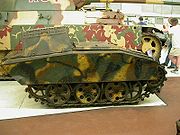.gif)
Springer (Tank)
Encyclopedia
The Springer was a demolition vehicle of the German Wehrmacht
in World War II
.
 Based on the well-known NSU
Based on the well-known NSU
Kettenkrad, the NSU Werke AG
at Neckarsulm
, Germany, developed and built around 50 Springer demolition vehicles in the final year of World War II.
To make the vehicle capable of carrying a bigger payload without the front fork, two pairs of road wheels were added to the running gear. The Springer had three outer and three inner running wheels. It was powered by the Opel Olympia engine, which was also used for the Kettenkrad.
The Springer was a demolition vehicle. Its task was to carry a charge of 330 kg high explosives under armor protection into a target and detonate it there.
A driver, who could sit in the back of the Springer, drove the vehicle close to the target. The final approach and the detonation of the charge was controlled by a wired or wireless remote control device.
The Springer showed the same problems as other remote-controlled demolition vehicles: They were expensive and they were not very reliable. They could be used only once.
, UK. Another example is preserved at the "Association pour la Sauvegarde du Patrimoine Historique et Militaire" (ASPHM), near Strasbourg
, in France.
Wehrmacht
The Wehrmacht – from , to defend and , the might/power) were the unified armed forces of Nazi Germany from 1935 to 1945. It consisted of the Heer , the Kriegsmarine and the Luftwaffe .-Origin and use of the term:...
in World War II
World War II
World War II, or the Second World War , was a global conflict lasting from 1939 to 1945, involving most of the world's nations—including all of the great powers—eventually forming two opposing military alliances: the Allies and the Axis...
.

NSU Motorenwerke AG
NSU Motorenwerke AG, normally just NSU, was a German manufacturer of automobiles, motorcycles and pedal cycles, founded in 1873. It was acquired by Volkswagen Group in 1969...
Kettenkrad, the NSU Werke AG
NSU Motorenwerke AG
NSU Motorenwerke AG, normally just NSU, was a German manufacturer of automobiles, motorcycles and pedal cycles, founded in 1873. It was acquired by Volkswagen Group in 1969...
at Neckarsulm
Neckarsulm
Neckarsulm is a city in northern Baden-Württemberg, Germany, near Stuttgart, and part of the district Heilbronn. As of 2004, Neckarsulm had 27,296 inhabitants....
, Germany, developed and built around 50 Springer demolition vehicles in the final year of World War II.
To make the vehicle capable of carrying a bigger payload without the front fork, two pairs of road wheels were added to the running gear. The Springer had three outer and three inner running wheels. It was powered by the Opel Olympia engine, which was also used for the Kettenkrad.
The Springer was a demolition vehicle. Its task was to carry a charge of 330 kg high explosives under armor protection into a target and detonate it there.
A driver, who could sit in the back of the Springer, drove the vehicle close to the target. The final approach and the detonation of the charge was controlled by a wired or wireless remote control device.
The Springer showed the same problems as other remote-controlled demolition vehicles: They were expensive and they were not very reliable. They could be used only once.
Survivors
An NSU Springer is displayed at the Bovington Tank MuseumBovington Tank Museum
The Tank Museum is a collection of armoured fighting vehicles in the United Kingdom that traces the history of the tank. With almost 300 vehicles on exhibition from 26 countries it is the second-largest collection of tanks and armoured fighting vehicles in the world.The Musée des Blindés in France...
, UK. Another example is preserved at the "Association pour la Sauvegarde du Patrimoine Historique et Militaire" (ASPHM), near Strasbourg
Strasbourg
Strasbourg is the capital and principal city of the Alsace region in eastern France and is the official seat of the European Parliament. Located close to the border with Germany, it is the capital of the Bas-Rhin département. The city and the region of Alsace are historically German-speaking,...
, in France.
See also
- Leichter Ladungsträger Goliath (Sd.Kfz. 302/303a/303b)Goliath tracked mineThe Goliath tracked mine - complete German name: Leichter Ladungsträger Goliath - was a remote controlled German-engineered demolition vehicle, also known as the beetle tank to Allies....
- Schwerer Ladungsträger Borgward B IV (Sd.Kfz. 301)Borgward IVThe Borgward IV, officially designated Schwerer Ladungsträger Borgward B IV , was a German remote-controlled demolition vehicle used in World War II.- Design :...
- Mobile Land MineMobile Land MineThe Mobile Land Mine was a British World War 2 remote controlled tracked explosive device. It was wire guided and powered by two electric motors.The Mobile Land Mine was designed by Metropolitan-Vickers 1940...
- TeletankTeletankTeletanks were a series of wireless remotely controlled unmanned robotic tanks produced in the Soviet Union in the 1930s and early 1940s. They saw their first combat use in the Winter war, at the start of World War II. A teletank is controlled by radio from a control tank at a distance of...

